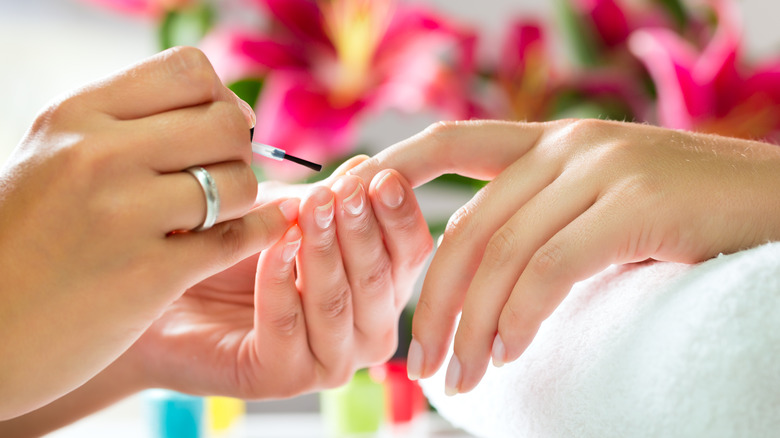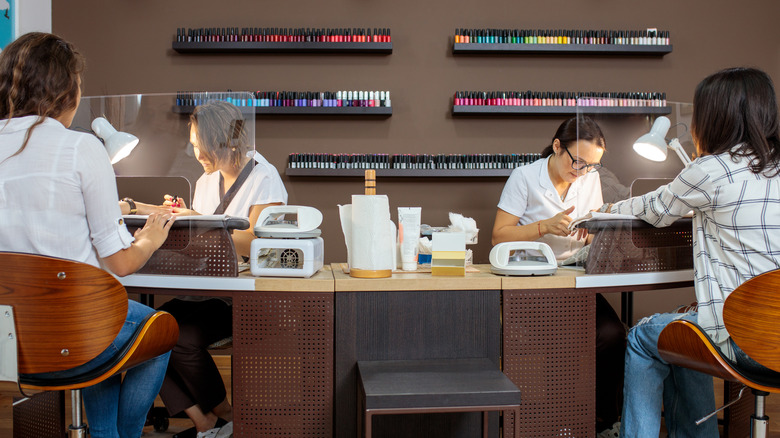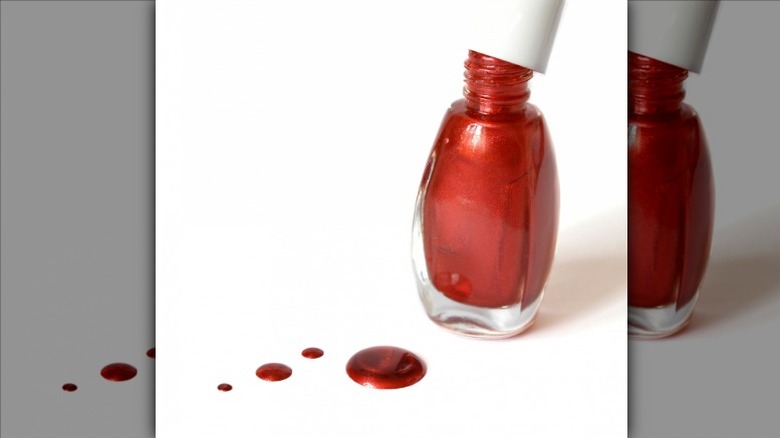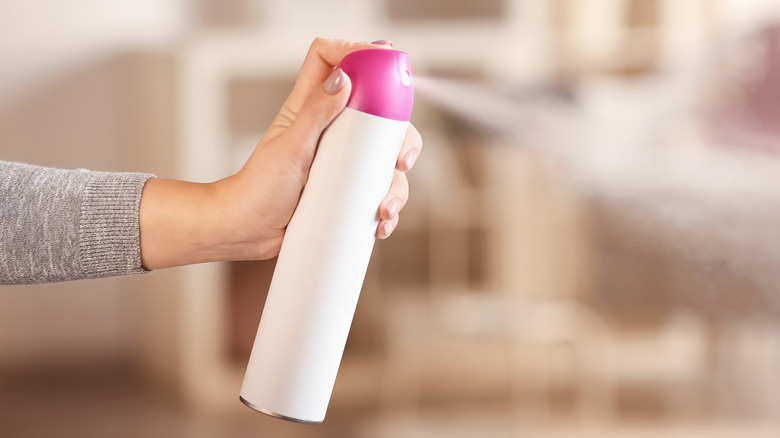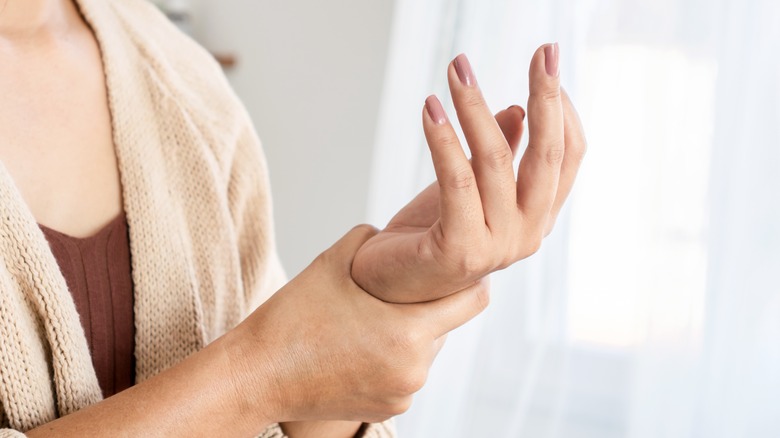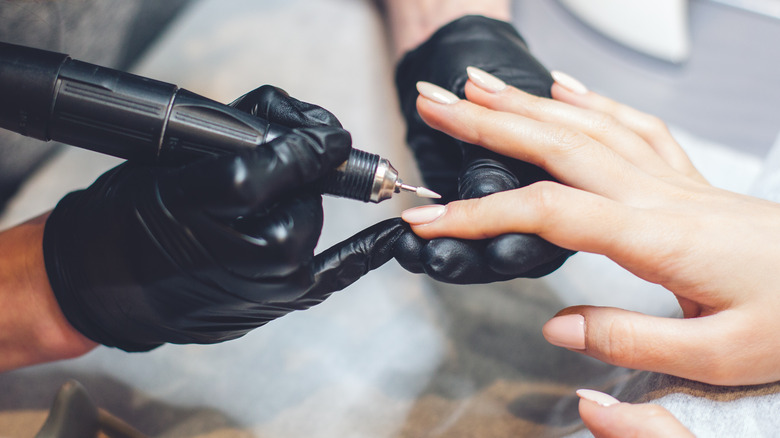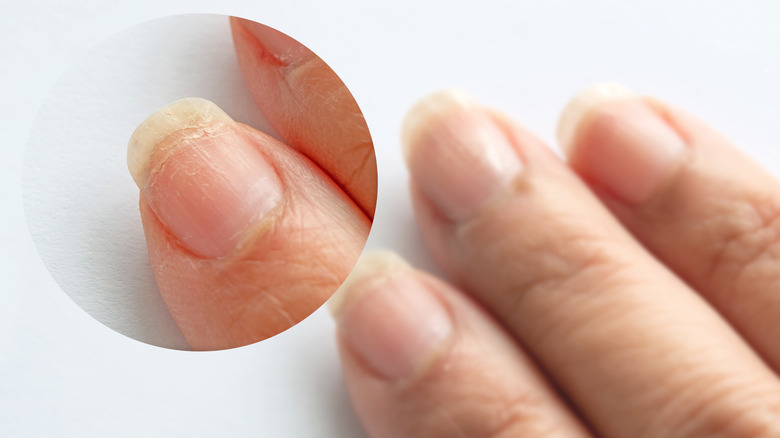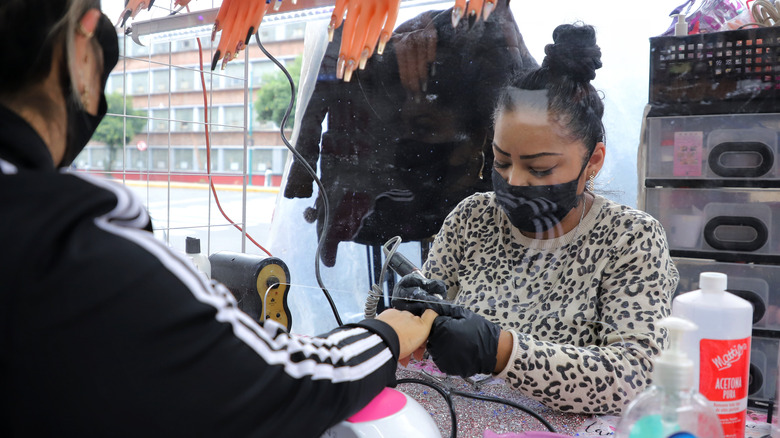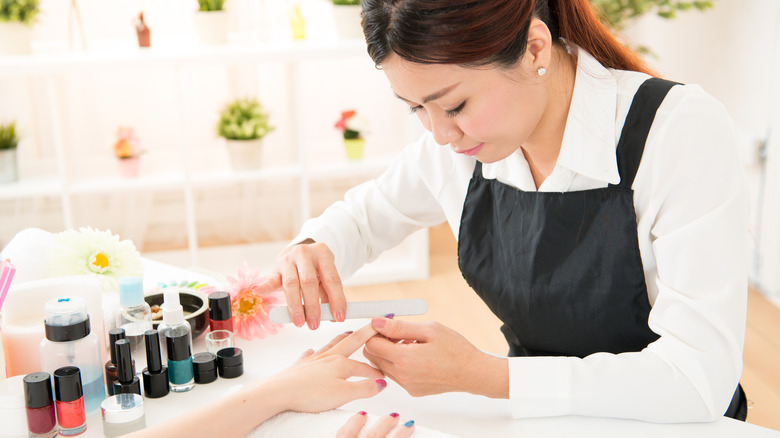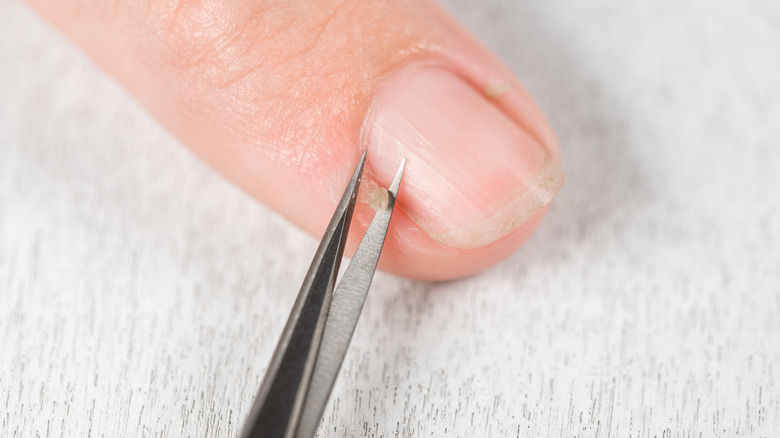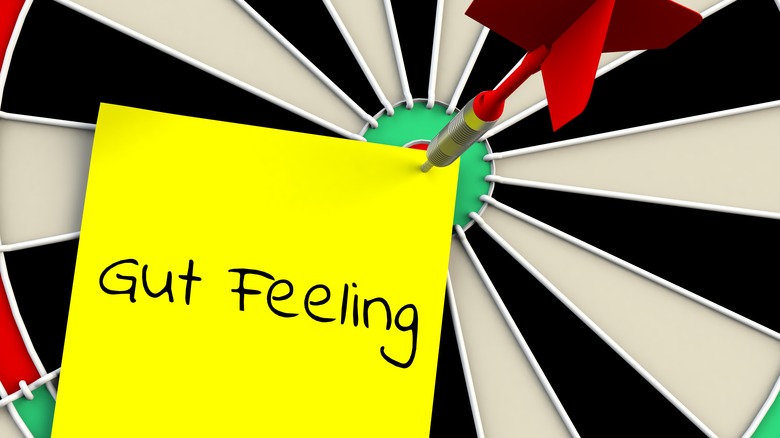Red Flags That Mean You Need To Switch Manicurists
Getting a manicure is something that helps women feel pretty. It makes us feel good, so we expect our manicures to go off without a hitch. But if and when this doesn't happen, we know it's time to make a change. One or more negative experiences is enough for us to seek out somewhere new.
With new research regarding the dangers of gel manicures that use UV lights for drying (via the New York Times), nail salons have come under additional scrutiny. However, the gel manicure is just one potential safety hazard that exists within a nail salon. From the cleanliness of the space and how hygienic their practices to a lack of transparency or willingness to respond to questions, a number of red flags are possible to spot within the nail salon.
Whether your manicures involve sprucing up your natural nails or getting refills of acrylic tips, these are the red flags that mean it's time to switch manicurists.
You question the cleanliness of the salon and its sanitation practices
If you've ever questioned a nail salon's sanitation practices, you likely had a good reason. After all, a salon's hygienic practices are crucial to the customers' health. "We all go into those corner nail salons, and there's dust everywhere — on tables, in drawers. That's stuff from other people's nails," celebrity manicurist Deborah Lippmann told Refinery29.
Does your manicurist wear gloves? That's a good thing. "Nail technicians should be wearing latex gloves as protection from transferring disease and fungus," said Ruth Kallens, owner of Van Court Studio, a health-focused salon in New York City, in an interview with The Zoe Report. And if your salon performs dip powder manicures, technicians must carefully follow sanitation procedures. "If handled improperly and product is reused from client to client, bacteria can certainly develop," nail technician Elaine Ling Lee told Insider. As such, salons must use new dipping powder for each client.
Foot spas, while feeling glorious on your feet, can be another source of infection. The United States Environmental Protection Agency provides sanitation guidelines for foot spas to avoid bacteria buildup that can lead to infections. Each should be disinfected with an EPA-registered hospital disinfectant between customers and daily after closing, and pedicurists should closely follow the instructions for proper disinfecting. Ask if you're ever unsure of a salon's cleaning practices.
A messy workstation or polish station is another red flag
While it's critical that nail salons follow proper sanitation procedures, a messy, cluttered salon can also be cause for concern. One such red flag is an uncovered trash can. Trash cans must be covered so that bacteria and mold are contained within it, as celebrity stylists shared with Refinery29. "Is the garbage overflowing in the trashcan? Are there dirty towels lying on the floor? ... I wouldn't want that type of thing to be in my home, so I don't want it in a salon that I'm having services performed in," Susan Stanford of the Texas Department of Licensing and Regulation told NBC5.
Moreover, look out for messy workstations and polish stations. "A neat station is a clean station," Cassondra Hughes, senior stylist at UltraViolet Nail Lounge in Atlanta, said in an interview with Essence. She advises stylists to clean up their work areas between clients to ensure that each gets a fresh set of tools.
Lastly, have you ever noticed bottles of nail polish where the polish is caked on all over the bottle? Perhaps, you were a bit turned off but convinced yourself it was nothing? As it turns out, this is also a cause for concern. Messy polish bottles indicate that the bottles had not been closed properly, allowing air to filter in and affect the quality of the polish.
You can smell the chemicals, many of which are harmful
You're probably aware that many nail salon products, including glues, polishes, removers, and emollients, contain harmful chemicals. These include toluene, formaldehyde, dibutyl phthalate, methacrylate compounds, and acetone (per the United States Department of Labor). And, if you ever notice a funny chemical smell while getting your nails done, this is another cause for concern because it means the salon is not properly ventilated. "That strong chemical scent is usually a clue," as board-certified dermatologist and Nu Skin nail health expert Dana Stern told Today.
According to Stern, two chemicals to avoid are ethyl methacrylate (EMA) and methyl methacrylate (MMA). "EMA can be found in the acrylic," nail technician Stephanie Ullrich shared with CBS8 NewsNow. She added that although MMA, which is used in medical and industrial settings, is banned from use in nail salons, some still use it in their products. Ullrich said she finds it used more often on new customers.
Many of these harsh chemicals can easily be avoided by making better choices. "A number of the harsh chemicals in nail salons are from toxin-laden nail polishes," Ruth Kallens, founder of Van Court Studio, a New York City nail studio that puts health and safety first, explained to The Zoe Report. "There is no reason why salons should use lacquers that aren't five-free. A number of high-quality brands produce long-lasting, healthier alternatives."
You experience discomfort or pain during your manicure
If you ever experience discomfort or pain during a manicure — including bleeding — look elsewhere for your nails. One unhappy customer posted to Treatwell about her negative experience, writing, "My local nail salon [has] left me with extremely sore fingers, three of which [I] cannot move due to the excess glue." The top response for her post asking about how she could file a formal complaint against the nail salon stated that it's likely this salon used products that are illegal in American and Australian nail salons.
If you've experienced pain while getting a manicure (especially a gel manicure), it's likely that the nail technician was inexperienced. Less experienced nail technicians or those looking to cut corners may use metal tools to hack or scrape at the nail to remove the polish, something that industry experts do not recommend, according to Refinery29.
Prices are too good to be true
With rising prices from inflation, manicures have become more expensive along with everything else. While a nail salon with low prices can be enticing, you should watch out: More often than not, these too-good-to-be-true prices come at another cost.
Some salons engage in unethical practices, including excessive and unreasonable work hours, a pay rate well below minimum wage, and unhealthy working conditions with regular exposure to toxins. "...As a rough ballpark, I would say you shouldn't be paying less than £20 for a gel manicure anywhere in the UK," as British industry expert Marian Newman shared with Stylist. "Less than that and the figures just don't add up."
If you encounter a nail salon that accepts only cash, this could be another red flag. While some salons do this to avoid paying credit card fees, this practice could indicate shady tax practices. If so, they're probably also not paying their workers adequate wages.
In 2015, the New York Times published an investigative report on industry exploitation and found nail salons in New York City — a city known for its high cost of living — which paid new employees only $10 a day. "You can be assured, if you go to a place with rock-bottom prices, that chances are the workers' wages are being stolen," according to Yale Law School lecturer Nicole Hallett.
Technicians use drills to remove gel polish
Does your nail salon use drills on soft nails to remove gel nail polish? If this is the case, listen up, because this is another red flag.
According to Mabelyn Martin, creative director at New York City's Paintbox nail salon, drills should only be used to remove hard gel polish or gel polish applied to acrylic nails. "Hands-down, never let a manicurist remove soft gel polish with a drill. It's more of a time-related thing for [salons] because not all salons want to allot 30 minutes to having the client soak their nails in polish remover to gently and properly remove the gel polish," she said (per Insider). "If you know you don't have acrylic nails and someone is using a drill to remove your polish, that's not a salon I would go back to."
Deborah Lippmann, a celebrity manicurist, agrees. "The right way to remove gels is what no one wants to do: You have to be super, super patient," she told Refinery29.
You notice unhealthy changes to your natural nails
If your manicures don't include tips and you notice unhealthy changes to your natural nails, it's likely you have an infection and should question your nail salon's practices.
Preventing infection is important for healthy nails. "Fungus grows in warm, moist places such as under nails," as Amanda Zubek, dermatologist and medical director at Yale Medicine Dermatology's Middlebury office in Connecticut, relayed in a Q&A for Yale Medicine. This is why nail fungal infections are more common during the summer or in warm locales. "When fungus has a chance to grow in the nail, it can turn into a fungal infection," said Zubek.
What should you look for? "Typical signs of a fungal infection include new white or yellow patches and streaks, but nails can also turn brown or green," she said, adding that lifting and thickening of the nail are also common. Nails might appear bumpy, have ridges with debris underneath, or could be misshapen or fall off, she added. Some nail infections, however, are due to bacteria. If this is the case, Zubek said, "you may notice redness, swelling, pain or pus in the skin surrounding the nail."
Per the American Academy of Dermatology Association, common fungal and bacterial infections of nails include onycholysis, which causes your nails to lift; paronychia, identified by swelling and redness; and acral lentiginous melanoma, identified by a dark streak across the nail. Others include pitting, yellow nail syndrome, Beau lines, and clubbing.
You don't see any licenses displayed at the salon
To become licensed, a nail salon must meet a variety of strict health and safety regulations. One way to tell if a nail salon is licensed is whether their licenses are displayed on the walls. If you've never noticed this, you should start looking. If no licenses are displayed where you can see them, this does not mean they do not exist. As Yale Medicine dermatologist Amanda Zubek advises, you can always ask the owner to see the salon's license, read customer reviews online, or check whether the salon is Better Business Bureau accredited.
Whether a nail salon visibly displays its licenses depends on the state. One state that does require this practice is Texas, where a team of inspectors from the Texas Department of Licensing and Regulation visit nail salons throughout the state to determine which ones may be in violation of this practice and other codes in place. "Every salon in Texas should have a Texas Department of Licensing and Regulation license," as Susan Stanford of the Texas Department of Licensing and Regulation told NBC5. "They can look for the last inspection report, and by looking at that report, they can see if the salon received any violations."
The manicurist doesn't speak to you
While you might not mind it if your manicurist doesn't make conversation with you while doing your nails, this could be another red flag. The New York Times' 2015 investigative report described nail technicians working silently in salons that engage in unethical practices.
"If the person doing your nails doesn't engage with you or with the other manicurists, that can be a warning sign that something's amiss," Justine Currell, executive director of an anti-slavery nonprofit organization known as Unseen, shared in an interview with Stylist. "Often workers being maltreated won't take payment from you themselves – they'll point to someone else for you to pay and may refuse a tip because they're not allowed to accept one."
While this one factor alone may not necessarily indicate an unethical nail salon, other red flags may provide additional clues, Currell added. So, it's good to keep your eyes open.
Nail technicians cut cuticles
Have you ever noticed whether your manicurist cuts your cuticles or pushes them down? It turns out that cutting cuticles is a big no-no in the nail world — it's actually illegal in some states! — so if your manicurist does this, it's a red flag.
"The function of the nail cuticle is to protect the new nail from bacterial and fungal infections as they grow out from the nail root," Corey L. Hartman, a physician and founder of Skin Wellness Dermatology in Birmingham, Alabama, told PopSugar. Because dirt and bacteria can more easily get trapped in your nail bed, dermatologists and manicurists advise against cutting them.
Another issue with cutting cuticles is if the tools used to cut them are not fully sanitized," as Tee Hundley, celebrity manicurist and Pedicure.com contributor, shared with Stylist.
Instead of cutting cuticles, your manicurist should push them back, then trim any hangnails as well as that loose, annoying skin around your fingernails. "You are less likely to have cuticle overgrowth and loose skin/hangnails when you have your cuticles regularly pushed back and exfoliated by rubbing in a circular motion with a towel after the shower and keeping them hydrated," according to Lisa Jachno, a celebrity manicurist.
Your goals and concerns are not met
If you don't get what you asked for or the salon owner is not responsive to your concerns, it's time to go elsewhere. "Ask to speak to the manager and inquire about red flags," Ruth Kallens, founder of Van Court Studio in New York City, shared with The Zoe Report. "If you don't feel comfortable with the response, don't frequent that business."
One woman got more than she asked for when her nails turned out nothing like the inspirational photo she gave the stylist. Sharing her experience in a video posted to TikTok which racked up over 40,000 views, the woman explained that she chose to "trust the process" at the time rather than voice her concern. ”[The nail technician] told me to put [my nails] in the setter and I didn't even want acrylic – I asked for SNS (dip powder manicure) but he talked me into getting them," she bemoaned. "...How embarrassing – and they've got bubbles in them” (via The U.S. Sun).
Then there are reports of customers being refused service because of their weight, such as Bianca Ballard of Byron, Georgia, who told NBC41, "As I was sitting there, the man came up to me and asked me how much do I weigh," Ballard said. "[Being turned away] hurt my feelings because it took a while to get to the point where I'm comfortable with myself ... he didn't pull me to the side or anything."
You don't trust it's the place for you
You know that feeling you get inside when something just doesn't feel right? That's your gut instinct, and it's important to listen to it. If you don't think a particular nail salon is for you, it's probably not. "If something feels creepy or you get bad vibes, that's your intuition telling you that something is not right," as Cassondra Hughes of UltraViolet Nail Lounge in Atlanta shared with Essence.
Customer Maya Cohen experienced this feeling firsthand. "There's just a lot of it [which] doesn't feel right," she said in a report for CBS8 News Now about some of the nail salons she's frequented over the years.
In fact, an investigation cited numerous salons and nail technicians in and around Las Vegas for being in violation of operating without a license. "The biggest thing is [to] protect yourself," Leah Easter, compliance coordinator for the Nevada State Board of Cosmetology, told CBS8 NewsNow. "If it doesn't seem right, it probably isn't right. Go somewhere else."
